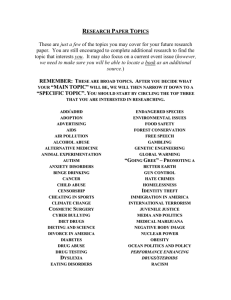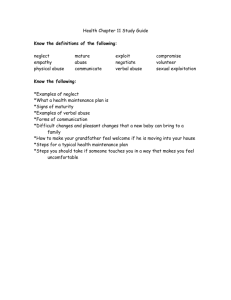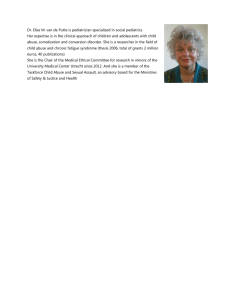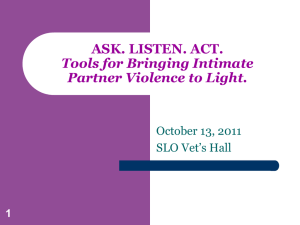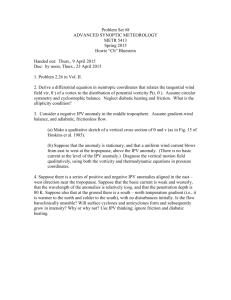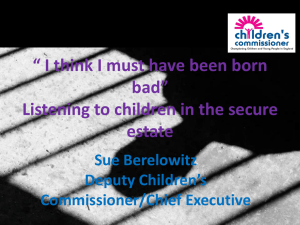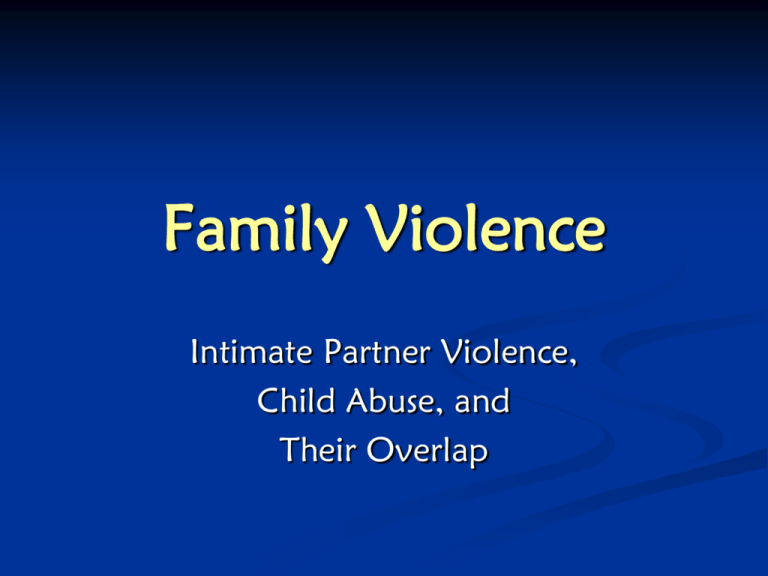
Family Violence
Intimate Partner Violence,
Child Abuse, and
Their Overlap
Deborah Lowen, MD
Associate Professor of Pediatrics
Medical Director, Children’s Justice Center
Tulsa, Oklahoma
Topics to be discussed
Intimate Partner Violence (IPV):
Child Abuse
Definitions, incidence, risk factors
Harm to children from IPV
IPV child abuse
Screening for IPV
Definitions, incidence, risk factors
Child Physical Abuse
Child Sexual Abuse
Effects of Family Violence
Protecting children
Intimate Partner Violence
Definitions:
World Health Organization: “Any behavior within an
intimate relationship that causes physical,
psychological or sexual harm to those in the
relationship”
Centers for Disease Control and Prevention: “A
pattern of coercive behaviors that may include
repeated battering and injury, psychological abuse,
sexual assault, progressive social isolation, deprivation
and intimidation”
Pre-test question
IPV is most correctly characterized as:
a.
b.
c.
d.
a sexual predilection or paraphilia
exerting power and control over another
sadistic behavior
punishing another for wrong behavior
What is Intimate Partner
Violence?
One person exhibiting power and control
over another
Takes many forms
Physical abuse
Sexual abuse
Intimidation, coercion, threats
Emotional abuse
Economic abuse
Social isolation
Pre-test question
IPV victims can include:
a. male victims of female perpetrators
b. males or females in homosexual
relationships
c. adolescents
d. all the above
Scope of the Issue
Between 10% and 69% of women worldwide
report being physically assaulted by an intimate
partner at some point in their lives
World Health Organization 2008
An estimated 1.5 million women and 830,000
men are physically or sexually abused by an
intimate partner annually in the United States
National Violence Against Women Survey 2000
In 2004, IPV resulted in over 1500 deaths in the
United States, 75% of whom were women
Scope of the Issue
When one considers emotional and
psychological abuse, it is estimated that
one in three women worldwide will be
abused in her lifetime
Population Reports 1999
22% lifetime prevalence of intimate
partner violence for females; 8% for males
National Violence Against Women Survey 2000
IPV Epidemiology
15%
Violence against women
Violence against men
85%
Bureau of Justice Statistics 2001
IPV Epidemiology
Same-Gender Partners:
Prevalence of approximately 25-35%
Gunther 1999
Similar types of violence reported
McClennen 2005
Adolescent Population:
Approximately one in three adolescent girls in the
United States is a victim of physical, emotional or
verbal abuse from a dating partner
Davis 2008
Two in five “tweens” (ages 11 and 12) report that
their friends are victims of verbal abuse in
relationships
Tween and Teen Dating Violence and Abuse Study 2008
IPV Risk Factors:
The Socio-ecological model
Individual
History of family violence during childhood
Mental health issues
Substance abuse
Relational
Conflict, instability, discord
Stressors (Financial, job, child-rearing)
IPV Risk Factors cont’d
Community
Poorly equipped to respond to the issue
“Refusing to take a stand”
Societal
Devalue the independence of women
Promotion of violence as a means of conflict
resolution
Pre-test question
Children living in homes with IPV are at
risk of harm due to all the following
except:
a.
b.
c.
d.
police involvement
direct physical trauma during IPV
long-term trauma from witnessing IPV
child physical abuse
IPV and the Child
“The abuse of women is a pediatric issue”
American Academy of Pediatrics 1998
Millions of children are exposed to IPV
every year
Children who grow up in homes with IPV
are at increased risk of harm:
As a victim of the abuse
As a witness to the abuse
The Child as a Victim of IPV
Pregnancy issues:
Increases a woman’s risk of being abused
Abuse often begins or accelerates during
pregnancy
Up to 20% of pregnant women are abused by
an intimate partner
Sharps 2007
The Child as a Victim of IPV
Indirect fetal risks:
Pyelonephritis
Chorioamnionitis
Higher HIV risk
Less prenatal care
Maternal polysubstance use
Chambliss 2008
Cokkinides 1999
The Child as a Victim of IPV
Direct fetal risks:
Preterm labor
Preterm delivery
Low birth weight
Uterine rupture/Placental abruption
Intracranial injury
Neonatal death, including elective abortion
El Kady 2005
Neggers 2004
Stephens 1997
The Child as a Victim of IPV
Injury to a child in the act of IPV may not
be a purposeful act against the child:
Infant being held in mother’s arms while she is
abused
Young children are often unable to get out of
harm’s way
Older children/adolescents may be harmed
trying to protect the abused caregiver
Case example 1
5-year-old girl’s parents in a fight
Police called, mother and children taken to
police station to file report
Child goes to restroom and urinates blood
Ambulance takes child to hospital
Child admitted to Pediatric ICU
Case example 1
Father tried to punch…mother? Child?
Struck child’s flank
Kidney fracture
Needed surgical procedure, several day
stay in PICU
Mother initially protective
8-year-old brother blamed child for
father’s removal from home
Case example 2
13-month-old boy presents to ED after a
shelf broke and a small glass bottle fell on
his head while he walked under it
Projectile vomiting in ED, then became
unconscious
Emergency CT done
Case example 2
Injuries: abrasions to scalp, large acute
subdural hemorrhage, brain bruise
Scene investigation
Shelf in trash
No holes in walls
No glass on floor
Unusual family arrangement
Interview with other kids: IPV between 2
adults in the home led to injury
Risk of exposure for infants
Impact on brain development
Increased irritability, increased crying, poor
health
Davidson 1978
Alessi 1984
Lack of responsiveness to adults, poor
eating, poor sleeping habits
Layzer 1986
Increased emotional arousal
Cummings 1981
Risk of exposure for school-age
children
Internalizing behaviors:
Anxiety
Depression
Withdrawal
Somatic complaints
Externalizing behaviors:
Attention problems
Aggressive behavior
Rule-breaking actions
McFarlane 2003
Hazen 2006
Risk of exposure for school-age
children
Social functioning difficulties
Aggressive with peers
Bullying
Poor academic performance
Long-standing stress/anxiety
Jaffe 1986
Propensity to continue the cycle of
violence
Kaufman 1987
The Child as a Witness to IPV
Adverse Childhood Experiences (ACE)
Study:
Self-report of adults in Kaiser Permanente
health plan
Response rate 68%: 9000 women, 8000 men
Mean age 55 +/- 15 yrs
Felitti 1998
The Child as a Witness to IPV
ACE definitions:
Verbal abuse
Physical abuse
Sexual abuse
Emotional neglect
Physical neglect
Household substance
abuse
Mental illness in
household
Parental separation or
divorce
Incarcerated household
members
Witness domestic
violence
The Child as a Witness to IPV
ACE Scores Related to IPV Exposure
Percent (%)
45
40
35
30
25
20
No
Yes
15
10
5
0
0
1
2
ACE Score
3
4+
The Child as a Witness to IPV
Adults exposed to IPV as a child
Emotional abuse
OR
6.0
95% CI
4.9-7.2
Substance abuse
5.6
4.9-6.3
Physical neglect
4.9
3.9-6.1
Physical abuse
4.8
4.2-5.5
Sexual abuse
2.6
2.3-2.9
Incarcerated household member
3.3
2.6-4.2
Parental divorce
3.9
3.4-4.4
Dube 2002
The Child as a Witness to IPV
Persons who had experienced four or more ACE
exposures had:
4-12 fold increased health risk for
2-4 fold increased health risk for
Alcoholism
Drug abuse
Depression
Suicide attempts
Smoking
> 50 sexual partners and STI
1.4-1.6 fold increased risk for
Physical inactivity and severe obesity
The Child as a Witness to IPV
The number of ACE exposures showed a
graded relationship to the presence of:
Ischemic heart disease
Cancer
Chronic lung disease
Skeletal fractures
Liver disease
IPV Exposure and Health
Outcomes
As the frequency of witnessing IPV as a
child increased, so too did:
Self-reported alcoholism
Illicit drug use
IV drug use
Depressed affect
The Child as a Victim of IPV
Co-occurrence of child abuse and IPV:
In 30 to 60% of families where one is
occurring, the other will be found.
Edelson 1999
If IPV present in the home:
Physical child abuse 3.4 times more likely
Child psychological abuse 2.0 times more likely
Child neglect 2.0 times more likely
McGuigan 2001
The Child as a Victim of IPV
In homes of abused children:
45% prevalence of physical violence against the
caregiver within her lifetime
29% of caregivers had one or more incidents of
abuse within the last year
Hazen 2004
IPV often precedes child maltreatment!
Pre-test question: screening
Screening for IPV
a. is universally accepted as a necessary thing
b. will identify the vast majority of victims of
IPV
c. can be considered a means of primary
prevention of child abuse
d. cannot be used with adolescents or
homosexuals
So maybe, screening for
IPV may help prevent
some child abuse
Not so fast, though…
Definitions
Screening
The application of an instrument or tool to a
set group of patients regardless of their reasons
for seeking medical care
Case-finding
The application of an instrument or tool to a
group of patients with specific signs, symptoms
or risk indicators
Screening
1. Does screening identify the target
condition?
2. Does the treatment lead to favorable
outcome?
3. Does screening do more good than harm?
Identifying the target population
How does IPV present?
Overt physical injuries are rare
Injuries may be covered by clothing
Injuries may be purposely masked by the patient
Recognize that women who are victims of IPV
may not seek medical care for themselves, but
rather will present with their children
Subtle signs are much more common!
Subtle signs of IPV
Depression
Anxiety
Failure to keep appointments
Reluctance to answer questions about home
Frequent complaints not borne out by evaluation
Presence of controlling partner
IPV Screening Efficacy
Publication
Population Screened
Number
Participating
Survey
Instrument
Overall IPV
rates
Bradley 2002
Women attending a
general practice
1692
Survey
developed by
Dobash et al
39%
95% CI 36-41%
Mothers seeking care
for their children in
an emergency
department
157
Modified Abuse
Assessment
Screen
52%
CI not reported
Mothers of children
seen for well-child
visit
553
Questions
recommended
by the AMA
16.5%
95% CI 1420%
Women attending a
general practice
1035
Unspecified
41%
95% CI 3844%
Mothers of children
seen for well-child
visit
154
Questions
recommended
by the AMA
31%
CI not reported
British Medical
Journal
Duffy 1998
Pediatrics
Parkinson 2001
Pediatrics
Richardson 2002
British Medical
Journal
Siegel 1999
Pediatrics
Barriers to IPV Assessment
Insufficient training/education
Insufficient time
Lack of appropriate resources
Fear of offending/angering the caregiver
Belief that IPV is not an issue in their
patient population
Individual Barriers to Seeking Help
Low self-esteem, guilt, self-blame
Fear of reprisal
Children
Need to keep family together
Importance of a paternal figure
Disruption of the children’s lives
Fear of CPS involvement and possible loss of
custody
More Individual Barriers to Seeking
Help
Gender considerations:
Males ashamed to disclose abuse by a female
Same-sex relationships:
“Double-closeted…conspiracy of silence”
McClennen 2005
More Individual Barriers to Seeking
Help
Failure to recognize violence as a problem
Conflicting emotional states
Love for the perpetrator
Hope for change
Practical concerns
Unemployment
Financial dependence
Current lifestyle
Social isolation
Societal/Cultural Barriers to Seeking
Help
Language barriers
Primary language
Cognitive or communication disorders
Cultural barriers
Consequences related to immigration status
Lack of community openness
Lack of perceived or actual community support
Stigma associated with shelter living
Invalidation by peers and family
Systemic Barriers to Seeking Help
Belief that legal system is not helpful
Lack of health care provider understanding
Lack of health care provider knowledge
Cost of medical care
Fear of CPS reporting
Efficacy of Intervention?
What services are available?
Primary care counseling
Referral to shelters
Referral to personal/vocational counseling
Batterer intervention
Structured advocacy services
Sullivan 1992:
Women followed longitudinally
Increased quality of life
Decreased rates of abuse (lost at 3-year study)
None of these are particularly targeted for children
Efficacy of Intervention?
“There is a lack of good evidence to guide
clinical decision-making, and no studies
have linked screening to treatment
intervention in a way that allows us to
determine whether routine screening for
violence against women does more good
than harm.”
MacMillan JAMC 2003
*Also review: Wathen JAMA 2003
Potential Harms of Screening?
Is there a risk of “reprisal violence?”
Post-shelter use
Children services reporting
Escalation of emotion
U.S. Preventative Services Task
Force
2004 recommendation on IPV screening:
“Insufficient evidence to recommend for or
against routine screening of…women for
intimate partner violence…”
Similar to findings of Canadian Task Force
on Preventive Health Care
IPV Screening Tools
Partner Violence Screen (3 items)
Feldhaus, JAMA 1997
American Medical Association (4 items)
AMA 1992
Abuse Assessment Screen (5 items)
McFarlane, JAMA 1992
Woman Abuse Screening Tool (8 items)
Lent, J Fam Pract 2000
Composite Abuse Scale (30 items)
Hegarty, J Fam Violence 1999
IPV Screening Rates
Publication
Population Screened
Overall Assessment Rates
Bair-Merritt 2004
Pediatric chief residents
21%
Practicing family and
pediatric physicians
8% and 5% respectively
National sample of 2400
physicians
10%
Primary care clinic
provider teams
<20% asking consistently
Child advocacy centers
29%
Ambulatory Pediatrics
Borowsky 2002
Pediatrics
Elliott 2002
J Gen Intern Med
Sugg 1999
Arch Fam Med
Thackeray 2007
Submitted to Child Abuse
and Neglect
How Best to Assess for IPV?
Verbally administered
assessments
Self-administered
assessments
Poorer detection rates
McFarlane 1991
Norton 1995
Freund 1996
Collins 1999
Less patient comfort
Anderst 2004
Bair-Merritt 2006
Thackeray 2007
Computerized survey
Written survey
How Best to Assess for IPV?
MacMillan JAMA 2006:
Randomized controlled study of three IPV screening
techniques:
Nearly 2500 participants asked to rate screening
techniques on:
Computerized
Face-to-Face
Written
Ease
Preference
Privacy
Face-to-face screening scored lowest in all three
domains
To Screen or Not to Screen?
Clinicians should:
Maintain a degree of awareness about the
issue of IPV
Be mindful of clinical presentations that
suggest risk
Be aware of the effects of IPV on the child,
and consider incorporating questions regarding
family violence into anticipatory guidance
Reporting Child Victims
What constitutes a child witness?
A child is a witness to domestic violence when
an act that is defined as domestic violence is
committed in the presence of or witnessed by
the child (5 states)
A child who is physically present or can
see/hear the violent act (14 states)
A child who is in the “vicinity” – within 30
feet or the same residential unit, regardless of
whether the child is actually present (1 state)
Child Information Welfare Gateway
Reporting IPV
Adult
victims
Child witnesses
Reporting Child Victims
As of July 2007, approximately 20 states
addressed, in statute, the issue of children
who witness IPV in the home.
Child Information Welfare Gateway
Reporting Child Victims
Does it matter who the child is?
Child must be related to the victim or the
perpetrator (10 states)
Laws apply to any child present (10 states)
Law applies only to the noncustodial child of a
noncustodial parent (1 state)
Child Information Welfare Gateway
Reporting Child Victims
When is witnessing IPV harmful to the
child?
Does a child sitting on the lap of his mother
during a violent episode have the same
experience as a child upstairs playing in the
bedroom?
Is there a threshold of exposure that causes
harm?
Zink 2004
Reporting Child Victims
What is the capacity of CPS to serve
children who witness IPV?
Budgetary and staffing constraints
Minnesota experience
What options are available to offer parents?
Respite care
Education and support groups
Home visitation programs
Zink 2004
Reporting Adult Victims
Does mandatory reporting of failure to
protect further victimize the
mother/victim?
Many researchers do not support removing
children in these situations
Is removal:
Helping the child?
Punishing the batterer?
Being used inappropriately against victims?
Zink 2004
Reporting Adult Victims
Guidelines for juvenile and family court
judges advise that:
“It is particularly short-sighted to remove
children from the care of their battered
mothers without first trying to remove or
change the source of the domestic violence
risk, the batterers.”
Schechter 1999
Reporting Adult Victims
How does mandatory reporting of the
child who witnesses IPV affect the
mother/victim’s disclosure of IPV?
Many women recognize the impact of IPV on
their children
Does mandatory reporting prevent mothers
from disclosing?
Zink 2004
A Therapeutic Approach
Knowledge of community resources
AMA/state medical associations
1-800-799-SAFE
www.endabuse.org
AAP’s Connected Kids program
Knowledge of existing state laws
Safety planning
Development of protocol/action plan
Conclusions
Intimate partner violence is not just a
violent act against a caregiver – it should
be considered a direct risk to a child’s
health
Intimate partner violence often precedes
child maltreatment and identification of
the former may prevent the latter
Conclusions
Although evidence is limited regarding IPV
screening, it seems reasonable to do so
given the risks to a child’s health and
development
Whenever possible, self-administered
assessments should be used as a screening
tool
The Child as a Victim of IPV
Co-occurrence of child abuse and IPV:
In 30 to 60% of families where one is
occurring, the other will be found.
Edelson 1999
If IPV present in the home:
Physical child abuse 3.4 times more likely
Child psychological abuse 2.0 times more likely
Child neglect 2.0 times more likely
McGuigan 2001
Pre-test question
What is the most common type of child
maltreatment?
a.
b.
c.
d.
Neglect
Emotional abuse
Sexual abuse
Physical abuse
Child Maltreatment
Centers for Disease Control and Prevention
(CDC) define child maltreatment as:
any act or series of acts of commission or
omission by a parent or other caregiver
that results in harm, potential for harm, or
threat of harm to a child
Risk Factors
Child
Parent
Family
Community
Risk factors: the child
Disability
Physical ailments/illness – require more care
Mental retardation, autism, etc.
Difficult “temperament” or behavior
Risk factors: the parent
Substance abuse
Depression
Other mental illness
Poor coping ability
Limited intelligence
Impulsivity
Poor anger control
History of having been maltreated
Risk factors: the family
Intimate partner violence
Poverty
Single parent
Multiple children
Stress
Lack of health insurance
Inadequate food
Lack of support
Risk factors: the community
Poverty
Crime
Violence
Substance abuse
Social isolation
Lack of supports
Parental “control” issues
Protective Factors
Child
Family
Community
Protective factors: the child
Good health
Normal development
Above-average intelligence
Hobbies and interests
Good peer relationships
Personality factors
Positive disposition and self-esteem, good
social skills, internal locus of control, etc.
Protective factors: the family
Secure attachment
Supportive family environment
Parental rules/structure
Extended family support & involvement
Parents with good coping skills
Family expectations of pro-social behavior
High parental education
Mid- to high-SES
Religious faith participation
Protective factors: the community
Access to health care & social services
Consistent employment available
Adequate housing
Good schools
Supportive adults outside of the family
Child Neglect: Definition
Helfer, Dubowitz:
“a condition in which a child’s basic needs are
not met, regardless of cause”
Acts of omissions
By those responsible for child’s health and
well-being
Actual and potential harm
Laws: clear and identifiable harm or injury
Failure to meet needs…
Food
Clothing
Shelter
Health care
Education
Supervision, safe-keeping, and protection
Nurturance
Incidence of Neglect
>50% of CPS substantiated cases
Physical neglect is most common
Nearly half of child fatalities due to
maltreatment are from some form of
neglect
Case-definition and labeling are a problem
Child Physical Abuse
An act committed by a caregiver that
results in a child being injured or harmed
Clinical definition broader than legal
definition
States have varying definitions
Fine line between corporal punishment
and child physical abuse
Evaluating the injured
child
MOST IMPORTANT
POINT:
ANY child can be
abused
ANY injury can be
abusive
Irrelevant facts
Race / Ethnicity
Marital status
Religion / church attendance
Housing
Socio-economic class
Interpersonal interactions
Listen to bad vibes
IGNORE the absence of bad vibes
Injury characteristics:
Physical abuse RED FLAGS
No history provided
Changing history
History inconsistent with exam findings
Implausible (laws of physics)
Injury too severe
>1 organ system involved
Injuries in various stages of healing
RED FLAGS cont’d
History developmentally impossible
Delay in seeking medical care
History not corroborated
Previous abusive / concerning injuries
Remember, ANY injury may be abusive,
even without red flags
A good History includes…
Exact details of the injury incident
Precipitating event
Child’s response to injury
Caregiver’s response to injury
Others in the home/with access to child
History from child, if possible
Important Past Medical History
Primary Care Physician
Growth, immunization status
Previous injuries
Detailed developmental history and
current abilities
Parental perception of child
A good Physical includes…
Growth parameters, plotted correctly on the
growth chart
Exact description of injuries, with
measurements/diagrams/photos
Close look at scalp, ears, frenula, palate, all skin
Eye exam
Neurologic exam
Palpate bones
Anogenital exam
X-rays
Skeletal survey
For children <2 years if concerned about
abuse
Must be done according to standards
NO BABYGRAMS
Obtain additional views if concerned
Skeletal surveys in older kids rarely needed depends on the specifics
Site-specific x-rays as indicated
The Key:
DOCUMENT,
DOCUMENT,
DOCUMENT!
Bruises
Pre-test question: bruises
A 3-month-old baby has a small bruise to the face. The
parents, who have no history with child welfare or law
enforcement, state that the child rolled over onto a toy in
his crib. An intern calls in a referral to child welfare (or
law enforcement) alleging possible abuse. The correct
course of action is to:
a. perform a complete investigation including interviews with
each parent and home assessment, as well as make sure child
receives a skeletal survey.
b. reassure the intern that this is not abuse based on the lack of
history with the family and the minor nature of the injury.
c. reassure the intern that this is not abuse because the history
matches the injury.
d. perform a screening assessment and close out the case when
nothing unusual turns up.
Pre-test question: bruises
A 15-month-old toddler has multiple bruises on his
forehead, shins, abdomen, and buttocks. They are of
different sizes and colors, with some being purple, some
green, some brown, and some yellow. A medical
provider provides you with ages for each of the bruises,
stating that some are 2 days old, some are 4, and some
are 7 days old. Your correct course of action is to:
a. determine who the child’s caretakers were on each of the days
in question, then interview each about the specific injuries.
b. place the child in protective custody due to concerns about
repeated abuse.
c. arrest the child’s parents due to the repeated abuse suffered by
the child and failure to protect from repeated abuse.
d. ask for another medical opinion from a different clinician.
Bruises
“Kids who don’t cruise don’t bruise”
Abdominal bruises on any child are
suspicious
Dating of bruises is imprecise!
Progression:
Red blue green yellow brown
Don’t try to estimate age, just describe!
Be concerned if…
Child not yet cruising
Bruises in abnormal location
Pattern marks visible
Multiple different ages
Burns
Burns
Beware of “the sibling did it”
Delay in seeking care is common
Burns change in appearance quickly
Look for pattern marks, symmetry, unusual
location
Is developmental ability consistent?
What happened before and after the burn?
Consider NEGLECT as contributing factor
Fractures
Pre-test question: fractures
Which fracture is always due to abuse?
a.
b.
c.
d.
transverse fracture of the humerus
oblique fracture of the humerus
spiral fracture of the humerus
none of the above
Fractures
Any fracture can be caused by abuse!
Need to correlate with mechanism of
injury
Spiral fracture: means torsion
Spiral fracture ≠ abuse necessarily!
Non-spiral fracture ≠ accident necessarily!
The absence of bruising does NOT rule out
abuse
Fractures
Myth: all spiral fractures are abuse
Fact: some spiral fractures are abuse, some
are not – just means torsion
Myth: all abusive long-bone fractures are
spiral
Fact: abusive fractures can be any type
Myth: CPR causes rib fxs in babies
Fact: CPR almost never causes rib fxs
Abdominal Injuries
Can present late – child already dying or
dead
Abdominal bruising may be indicator of
underlying injury
Any abdominal organ can be injured, esp:
Liver
Small intestine
Pancreas
Symptoms and Signs
May be subtle, initially
Abdominal pain, vomiting, shock, lethargy,
death
Time depends on which organ is injured
Liver - > bleeding
Intestine - > infection
Head Injuries
Components of AHT
Head injury - neurologic injury
subdural hematoma or other intracranial
bleeds or injury
Retinal hemorrhages
Associated fractures
Few, if any, external physical findings
AHT: Clinical Presentation
Often non-specific
Vomiting
Irritable
Poor feeding
Low grade fever
Altered mental status
Seizures
Apnea
AHT: Mechanism of Injury
Impact injury – soft or hard surfaces
Infants are uniquely susceptible to shaking
injury
Relatively large heads
Relatively weak neck muscles
Neurological Outcomes
12-25% mortality
22-30% normal
50% with variable levels of cognitive or
neurologic impairment
Can’t always tell right away!
Important points about AHT
Short falls only cause major injuries in very
unusual circumstances
The subdural hematoma of a shaken baby is
NOT the primary injury - the injury to the
neurons is
There are many causes of retinal hem; some RH
are non-specific
Clinicians won’t diagnose it unless they think of
it! (non-specific symptoms are common)
AHT
In one study:
31% of children with AHT were not diagnosed
at first presentation
27% of those were re-injured
40% had medical complications
In another study:
45% of AHT kids had evidence of prior injury;
no accidental TBI kids did
Sexual Abuse
Pre-test question: Sexual abuse
A 6-year-old girl has disclosed sexual abuse by her mother’s
boyfriend. She told her father that he had been rubbing her genitalia
on top of her clothes. She told a forensic interviewer that for the last
6 months he has been putting his finger in her vagina and it hurts. A
medical examination reveals that the child has a normal hymen.
Your correct course of action is to:
a. ask the family if the child has a history of lying or of discord with the
mother’s boyfriend.
b. tell the family that the child must have made up the allegations
because her hymen is normal.
c. tell the family that the child must have made up the allegation
because her disclosure changed.
d. schedule an interview with the boyfriend and tell the family to keep
the child away from him while you continue to investigate.
How common?
? 1% of children experience some form of
sexual abuse each year.
By 18 years of age:
12-25% of girls
8-10% of boys
AAP Clinical Report, The Evaluation of Sexual Abuse in Children, Pediatrics,
August 2005
How common really?
Who knows?
Highly under reported
Secretive, hidden offense
Disclosure without appropriate intervention
Children’s fear of disclosure
Fear of perpetrator’s threats
Embarrassment / shame
Concern for disrupting the family or for perpetrator
Perpetrators
Usually a relative or friend
Rarely an attack by a stranger
Build trust over time (grooming)
Hold position of trust or authority
Mostly male (90%)
20% adolescent perpetrators!
Evidence in SAb Cases
Most common
Least specific
1.
2.
3.
4.
Least common
Behavioral changes
Disclosure
Physical exam findings
Pregnancy, witnesses,
semen, etc.
Most specific*
Behavioral changes
Regression – bed wetting, thumb sucking
Clingy Behavior – return of separation
anxiety
Sleep Disturbances – nightmares, inability
to sleep alone
Change in Appetite
School Problems – declining performance,
attention problems
Behavioral changes, cont’d
Social Problems
aggression / anger with peers or family
members
Sexualized play inappropriate for age
Substance Abuse
Psychiatric
Depression
Suicidal Ideation or Gestures
Self-injurious Behavior
Behavioral changes, cont’d
Important to distinguish developmentally
appropriate from precocious behavior
Classic example – masturbation
Often normal behavior
Can appear at 12-18 months
Concern when it occurs in excess (?)
Usually manual stimulation, concern with use of
foreign objects
Some, but certainly not all, children who masturbate
are victims of sexual abuse.
Sexualized behavior
Developmentally precocious and concerning
behaviors include the following:
Attempts at intercourse or simulated intercourse
Putting mouth on other’s genitals
Asking others to participate or perform sex acts
Elements of force
May be alternative explanation, though
Porn on internet or TV
Inappropriate exposure to sexual activity
Disclosure
Disclosure is a process, not an event
Rarely does complete disclosure come out all at once
“Change” in statements may not indicate lack of
credibility
Don’t discard disclosures with fantasy elements
Minimize interviews
Allow free narrative format
Keep child’s age and development in mind
Physical exam findings
Myth: If a girl has been abused, her
hymen will be torn/gone
Fact: >90% of abused girls have
NORMAL exams
Corollary: a normal exam tells you nothing
about abuse
Physical findings
Myth: All SAb kids need a SANE exam
(rape kit)
Fact: SANE exams are only for acute (<72
hours) cases
Corollary: most cases are not emergencies and
the exam can wait
Physical findings
Exams are best done not in the ED
Purpose of exam:
□Injuries
□STDs
□Evidence
□Normality
Clinicians need to know normal anatomy
Don’t underestimate the elasticity of the
anogenital area
Anatomy
Normal prepubertal girl
Normal infant girl
Normal adolescent girl
Exams
A speculum exam should NEVER be done
on a prepubertal girl unless she’s under
anesthesia – very rarely needed
A competent clinician should be able to do
the exam with traumatizing the child
It’s okay to wait for the child to be
emotionally stable before doing the exam
Mimics
Medical conditions or accidental trauma
can confuse a clinician!
Lichen sclerosis
Urethral prolapse
UTI
Hemangioma
Labial agglutination
Straddle injury
Most specific findings
Witness to the abuse
Presence of semen
Pregnancy – with DNA testing
Sexually transmitted infections
Gonorrhea
Syphilis
Chlamydia
(NOT warts or HPV, though)
STI’s must be tested for in the right manner!
Prevention
Much harder than recognition!
Prevention
Secondary/tertiary prevention
Recognition of abuse going on
Prevention of further abuse, or of sibs
Home visitation
SBS education programs
Applicability to Child Abuse
All those with “primary” information:
parents, grandparents, teachers, doctors,
nurses, social workers, daycare providers,
babysitters, etc.
All those who need information:
Doctor, CW case workers, law enforcement,
prosecutors, foster parents, defense attorneys,
etc.
Applicability to Child Abuse, cont’d
Each organization has different goals:
Medical: patient care
CW: safety of the child (family preservation?)
Law enforcement: identifying the perpetrator
Prosecution: prosecuting the defendant
Social work: depends on the specific
environment
Need to move from this...
medical
DHS
Police
CHILD
SW
prosecutor
...to this!
Turf battles and the Silo
effect may cause harm to
a child!
Communication is the key!
But...
...you need the right people on the team!
Medical Providers:
Poorly trained – if trained at all
Don’t want to be involved
Don’t evaluate the child appropriately
Don’t document thoroughly
Won’t/can’t testify

